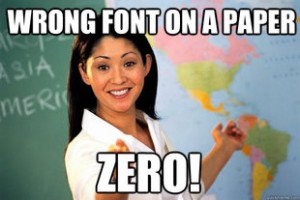This is the post for the September 26, 2014 class meeting.
Today we are going to talk about memes: how they are made, why they work, and why they sometimes fail. I have shared the Notes on the Project 2 Web Essays on Google Drive.
Important Dates
- October 1: Sign up for a presentation time slot in class
- October 8: Draft of P2 due in class for Peer Review
- October 13, 15, or 17: Presentation Days (no grace period)
- October 17: P2: Interrogate the Interface web essay due
- October 24: P2: Interrogate the Interface deadline (end of grace period)
Choosing Your Interface
If you have not yet done so, go to the Project 2 Sign-Up and choose one of the remaining tools for your project. Remember you are governed by the Honor Code (so don’t remove someone else’s name to add your own).
Introduction to Memes
 For today, I asked you to read the Introduction to Memes and explore some of the links on the page. A meme can be anything—an image, a catch phrase, a video clip, a gesture. For our purposes today, we will think specifically about the image memes that you frequently see online. If your Facebook News Feed is like mine, you see this type of meme all the time.
For today, I asked you to read the Introduction to Memes and explore some of the links on the page. A meme can be anything—an image, a catch phrase, a video clip, a gesture. For our purposes today, we will think specifically about the image memes that you frequently see online. If your Facebook News Feed is like mine, you see this type of meme all the time.
What I would like to do is look at some original versions of some memes and apply what we know about multimodal composing to how they work. We’ll use the short definitions from the slideshow I shared last session to work through some examples.
Meme Guidelines
I want each of you to create a meme image that you will publish on your blog (and elsewhere if you like). Your audience will be other students at Virginia Tech (or all college students generally). Your purpose will depend upon what topic you choose to focus your image on (e.g., to be entertaining, to draw attention to something on campus, to correct a myth/misunderstanding).
There are a few important guidelines:
- Please keep the image clean. No inappropriate images of naughty, naked bits or bloody, gory things please.
- R-rated language can be okay if it fits the message. Explicit descriptions of things done with naked bits are not.
- Try to work within the Virginia Tech Principles of Community. Nothing racist, sexist, homophobic, etc.
Beyond those guidelines, you can do what you want. If you aren’t sure, you can always ask me.
Making Your Memes
There are two ways to go about this activity.
- You can begin by choosing a topic. Your meme could focus on something about campus, classes you are taking, or special events taking place recently. You can make a “What I really do” meme. If you want to get out and about, you might try contributing to one of the Photo Fad memes (think planking, owling, or Tebowing). You can focus on things unrelated to campus and being a student as well.
- You can begin by looking at existing memes. You can look at the memes on any of the sites linked below to see what other people have done, and then when inspiration hits, go with it. Do realize that you may happen upon inappropriate images and messages.
These tools all help you make memes. They are generally the same. You can play with the different tools to see is one offers you an affordance that will help you:
If you want to play a bit, feel free to make more than one meme image. Post them all on your blog, but tell us which one is your favorite in the linguistic text of your post.I’d love to see evidence that you took some risks and tried multiple options.
Also, if you’re interested in LOLcats, be sure to check out “Cats Can Has Grammar.”
Homework/Schedule
M, 9/29: Write a blog post that shares the meme you make. You can also share your meme online, wherever you like (e.g., your Facebook timeline). We will go through the examples in class on Monday.
W, 10/1: We’ll talk about the expectations for the oral presentation (and how to avoid bad PowerPoint presentations) and you will sign up for your oral presentation time slot.
F & M, 10/3 & 10/6: You will have time to work on your second project in class. I’ll share some additional resources, and have a quick conference with each of you to answer any questions.
W, 10/8: You’ll exchange Project 2 drafts and complete peer review in class.